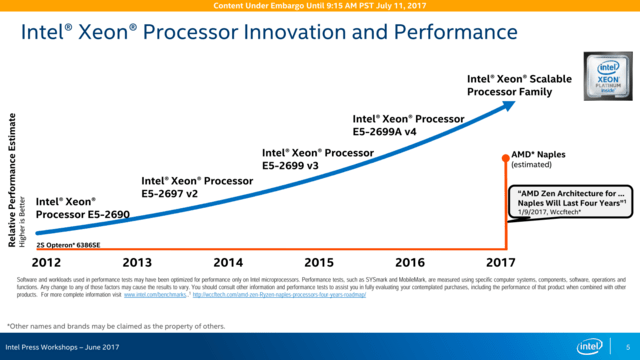Install the app
How to install the app on iOS
Follow along with the video below to see how to install our site as a web app on your home screen.
Note: This feature may not be available in some browsers.
You are using an out of date browser. It may not display this or other websites correctly.
You should upgrade or use an alternative browser.
You should upgrade or use an alternative browser.
Wccftech or not, it might not even be fair to say Intel is quoting them, since it's a heavily cut up article title with words that would significantly reverse the meaning missing.It's one that implies that naples will last 4 years without updating while Intel chips will update yearly.
Yes its almost false advertising but it doesn't say that directly its just show in a way that makes you(if ur stupid enough) think that.
That seems like an unusually bad-faith choice, with Intel outsourcing its description of the competition to a third party article, which is itself a repeating of a PCWorld interview--and then just a fraction of the headline.
"Sizing Up Servers: Intel's Skylake-SP Xeon versus AMD's EPYC 7000 - The Server CPU Battle of the Decade?"
http://www.anandtech.com/print/11544/intel-skylake-ep-vs-amd-epyc-7000-cpu-battle-of-the-decade
http://www.anandtech.com/print/11544/intel-skylake-ep-vs-amd-epyc-7000-cpu-battle-of-the-decade
hoom
Veteran
Just incase you didn't find it yetI really need to look at this official slide lol.
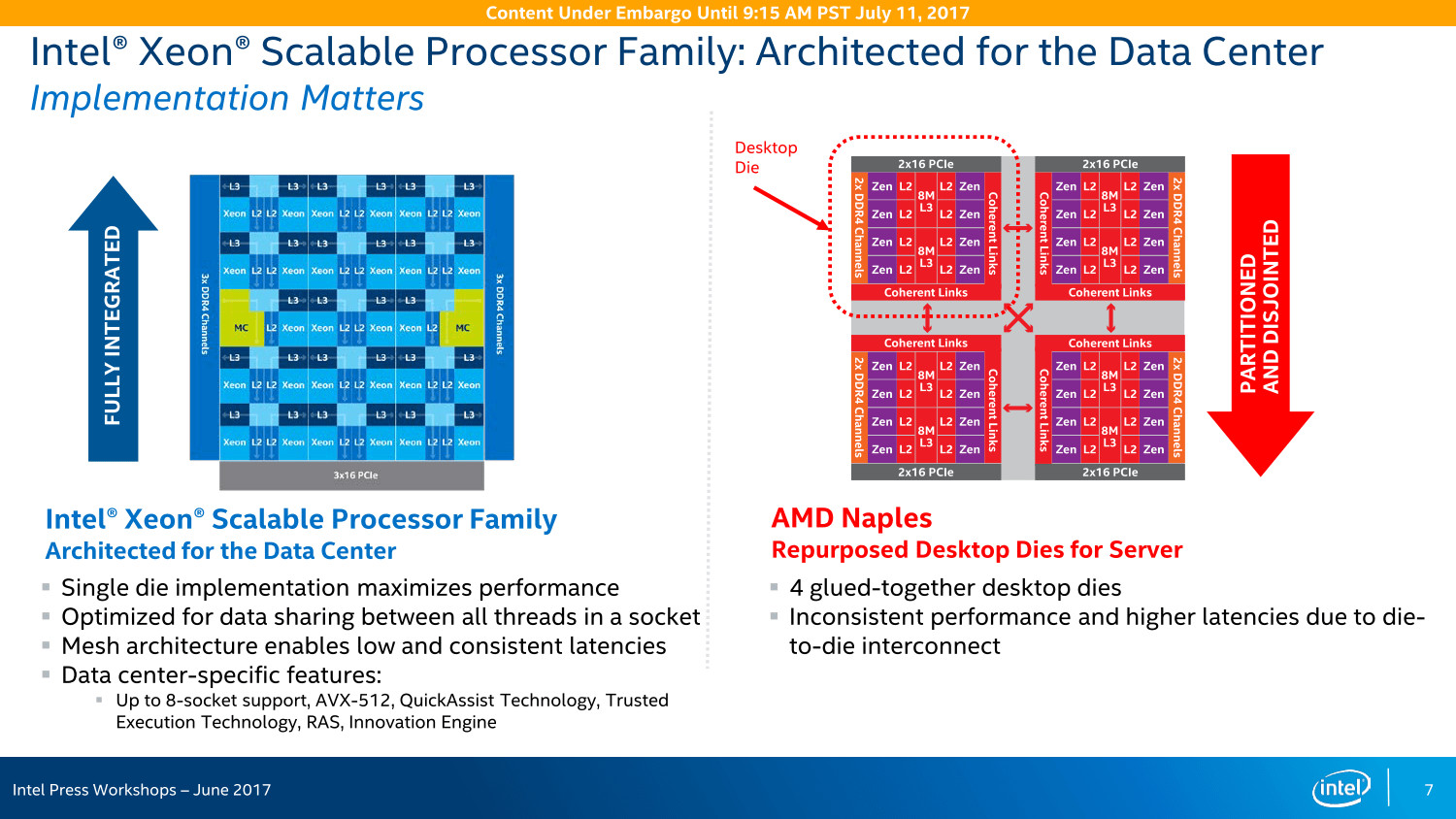
Edit: modified sig for the new glue age

Edit2: full deck at https://www.computerbase.de/bildstrecke/78687/1/
particularly funny ones where Intel wins massively! (as long as you only count per-die not per-socket)
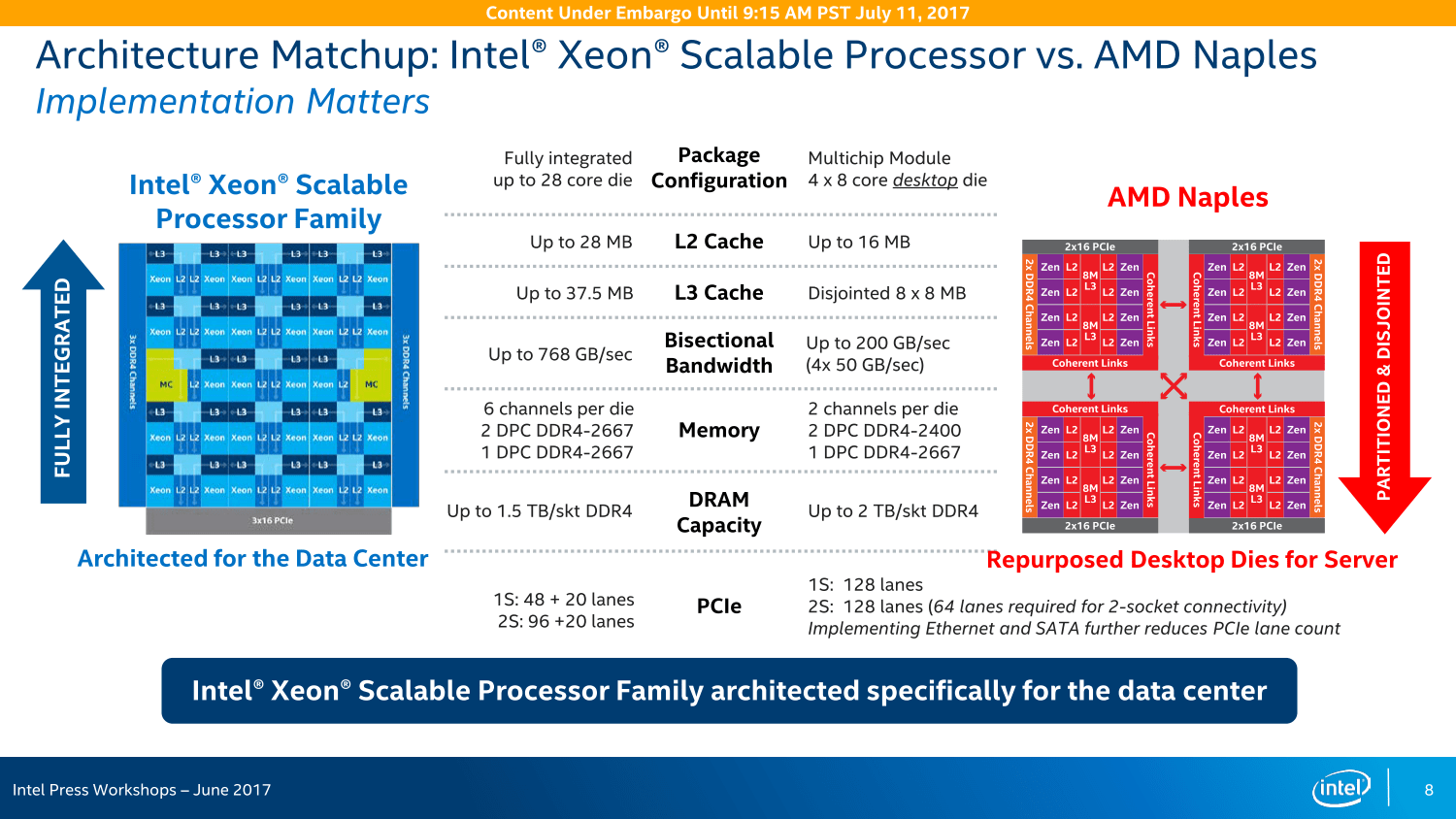
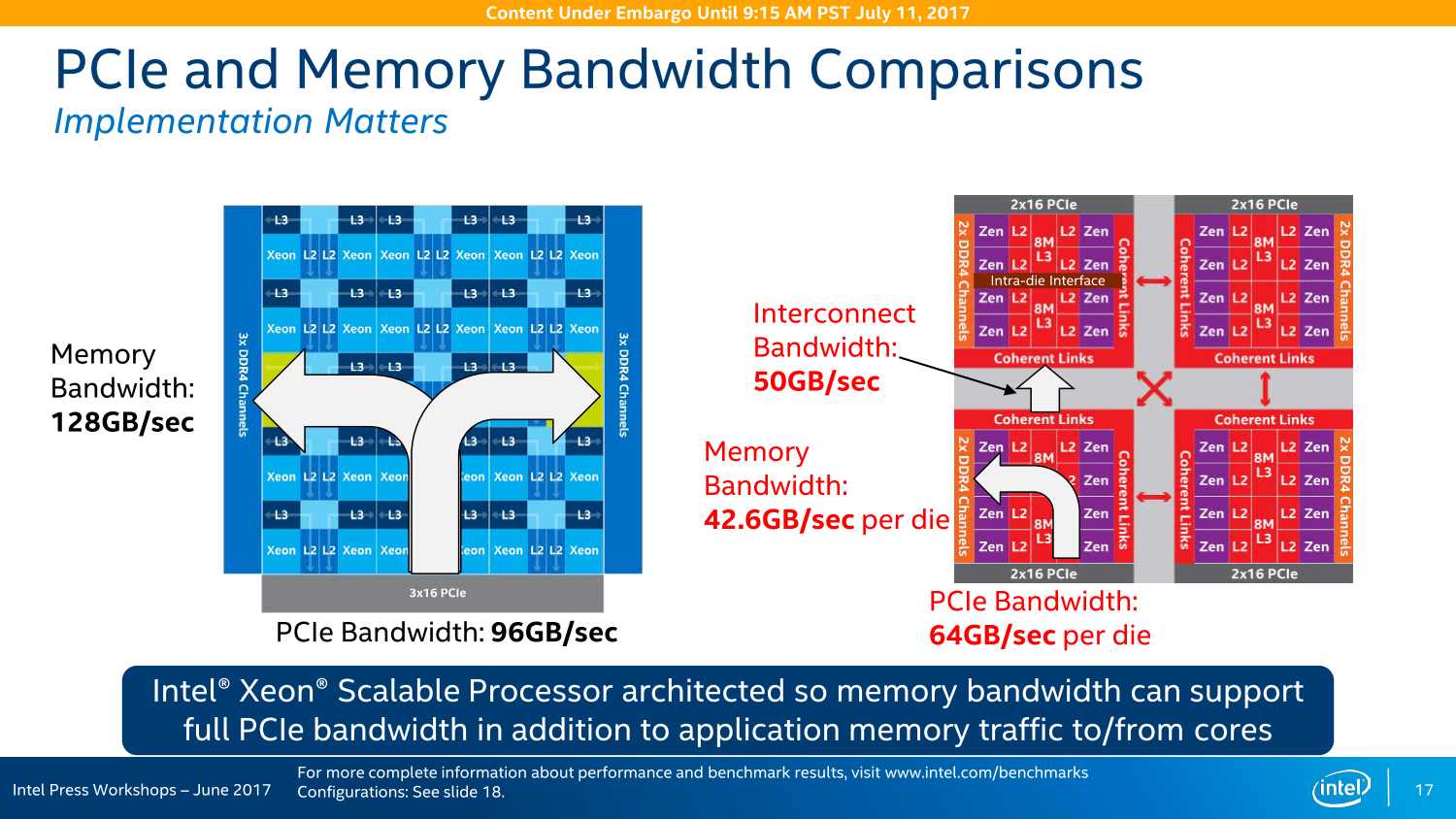
Last edited:
Silent_Buddha
Legend
Is it just me or did this whole argument from Intel make you think of the Pentium D versus Athlon 64 X2 processors. It's not directly comparable, but the similarity albeit with roles reversed has me smiling as we come full circle. Only this time the "glued" together dies was planned well in advance rather than being hastily put together in order to beat the competition to market.
Regards,
SB
Regards,
SB
Them are fighting words.
So how stupid will Intel look if "a bunch of glued together desktop dies" outperforms their single die highly optimized wonder ?
Cheers
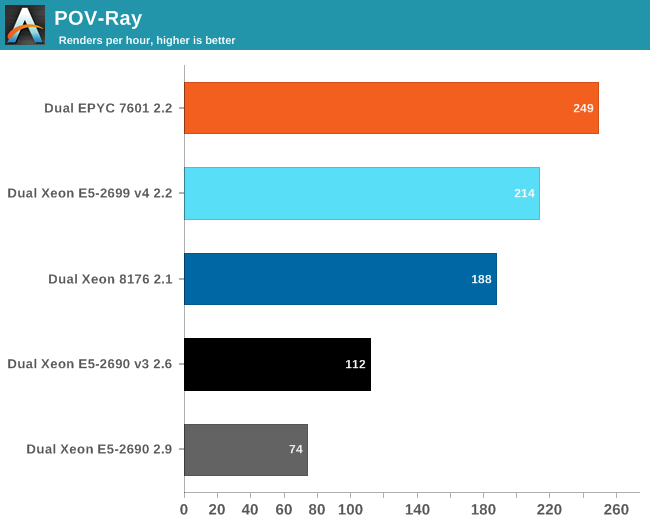

In that example the dual Epyc 7601 setup is outperforming the dual Xeon 8176 by 32% in raw performance, while consuming 38% less power at half the price of the dual Xeon setup. It doesn't look good. Although, the dual Xeons should perform better in single-threaded applications or AVX dependent ones.
In that example the dual Epyc 7601 setup is outperforming the dual Xeon 8176 by 32% in raw performance, while consuming 38% less power at half the price of the dual Xeon setup. It
That's not a server workload though. It's an embarrasingly parallel workload.
Platinum Xeons will beat Epyc when there is a fair amount of inter-process communication, otherwise Epyc will beat Xeons.
The optimal showcase for Xeons is probably something like a big DBMS installation (Anandtech's analysis also shows Xeons outperforming Epyc in MySQL). I'd imagine the optimal showcase for Epyc to be hosting densely packed 4 core VMs, which would map well to the CCX sub structure, the high RAM capacity also helps.
Cheers
Anandtech's analysis also shows Xeons outperforming Epyc in MySQL
The problem with that test is that they eliminate IO bottleneck by using a database smaller than the L3 cache in size. How many large databases are in the < 38mb range?
At least they said that:
A small database that can be mostly cached in the L3-cache is the worst case scenario for EPYC.
It'd be interesting to see how it performs in a real world scenario.
The problem with that test is that they eliminate IO bottleneck by using a database smaller than the L3 cache in size. How many large databases are in the < 38mb range?
None ? But it's a read only test, making it a best case for Epyc.
Real OLTP will be worse, because UPDATEs and INSERTs require locking rows/pages they touch. That means a lot of inter-core traffic.
Cheers
16/32 @ 3.4 for $999 is great, well done AMD.... :smile:
Anandtech aligns Threadrippers direct competitor, the i9-7980X, with the Xeon Gold 6150. The 6150 has a TDP of 165W, and a base clock of 2.7GHz. However the Xeon has three UPI link that will be disabled, and the power budget for those could be used to boost CPU performance. It won't be much though, the 200W 6154 has a 3GHz base frequency; I would expect a 2.8/2.9GHz base frequency (and crazy one/two core boost frequency).
Threadripper looks like it will be competitive, not only in performance/$ but in outright performance as well.
Cheers
itsmydamnation
Veteran
Do we know die size of the new xeons?
Someones review has it listed for all 3, HCC is like 670mm sq.
cheers
Once again from the Anandtech review, Epyc vs Skylake/Broadwell Xeons on different workloads:
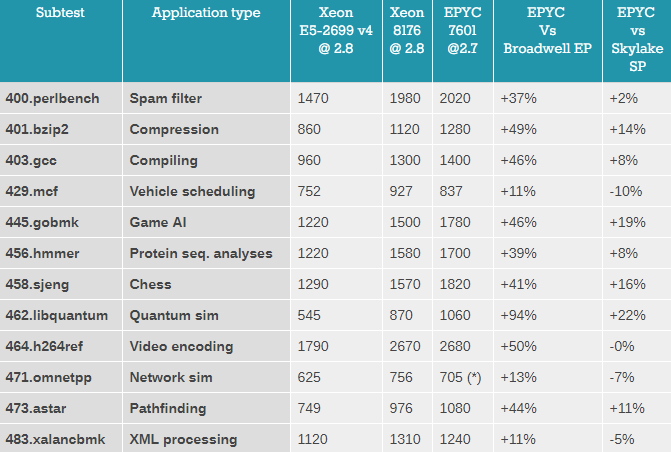
On average +8.5% in comparison to the Skylake Xeon and +40% in comparison to the Broadwell Xeon. In both cases the Epyc CPU is at a frequency disadvantage (about 3.5% slower).

On average +8.5% in comparison to the Skylake Xeon and +40% in comparison to the Broadwell Xeon. In both cases the Epyc CPU is at a frequency disadvantage (about 3.5% slower).
Once again from the Anandtech review, Epyc vs Skylake/Broadwell Xeons on different workloads:
SpecInt Rate has zero inter-core communication, it runs one instance per thread/context.
Cheers
SpecInt Rate has zero inter-core communication, it runs one instance per thread/context.
Cheers
So that should be ideal for Epyc, right? But even then that's a pretty good result against the two different Xeon architectures all things considering.
So that should be ideal for Epyc, right? But even then that's a pretty good result against the two different Xeon architectures all things considering.
It proves Epyc has very high performance per core, which is certainly encouraging . We don't really know how Epyc performs on large server apps, like SAP HANA or as DBMS backends.
AMD have been absent from the server space for five years. They are effectivelyt starting from scratch. None of the big server OEMs are going to build large Epyc servers off the bat.
Back in 2005, when the Athlon X2 launched and beat the competition silly, you couldn't get an Athlon X2 server for almost a year from the big OEMs. All the servers where taiwanese 1U white boxes. Then IBM started to offer X2 based 1U and 2U servers and things progressed from there.
I expect something similar now. Cheap single socket 1U units first, then compact single and dual socket servers.
Cheers
Similar threads
- Replies
- 67
- Views
- 11K
- Replies
- 90
- Views
- 17K
- Replies
- 220
- Views
- 92K

